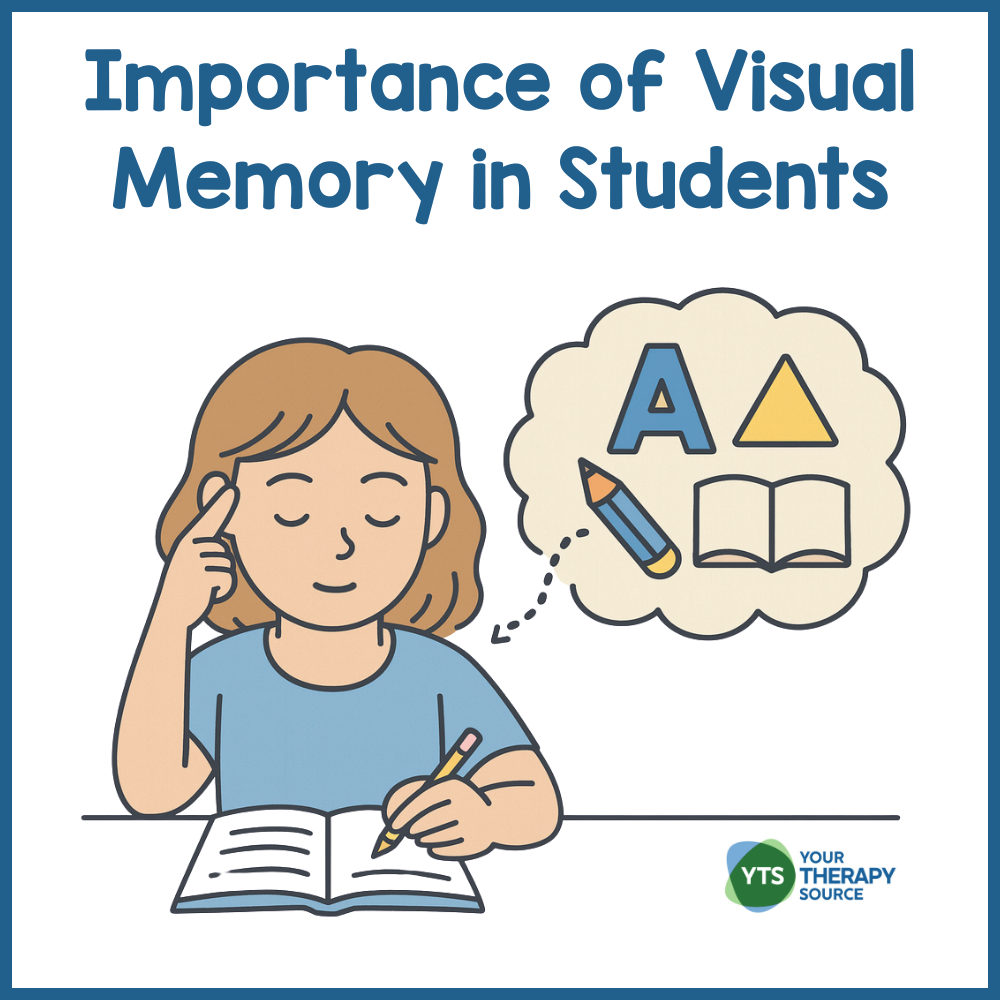The Importance of Visual Memory Skills in Students
Visual memory plays an important role in how students learn, remember, and understand the world around them. From reading and spelling to copying from the board or recalling visual details from lessons, strong visual memory helps students store and retrieve information efficiently. When this skill is weak, learning can feel slow, confusing, and frustrating.
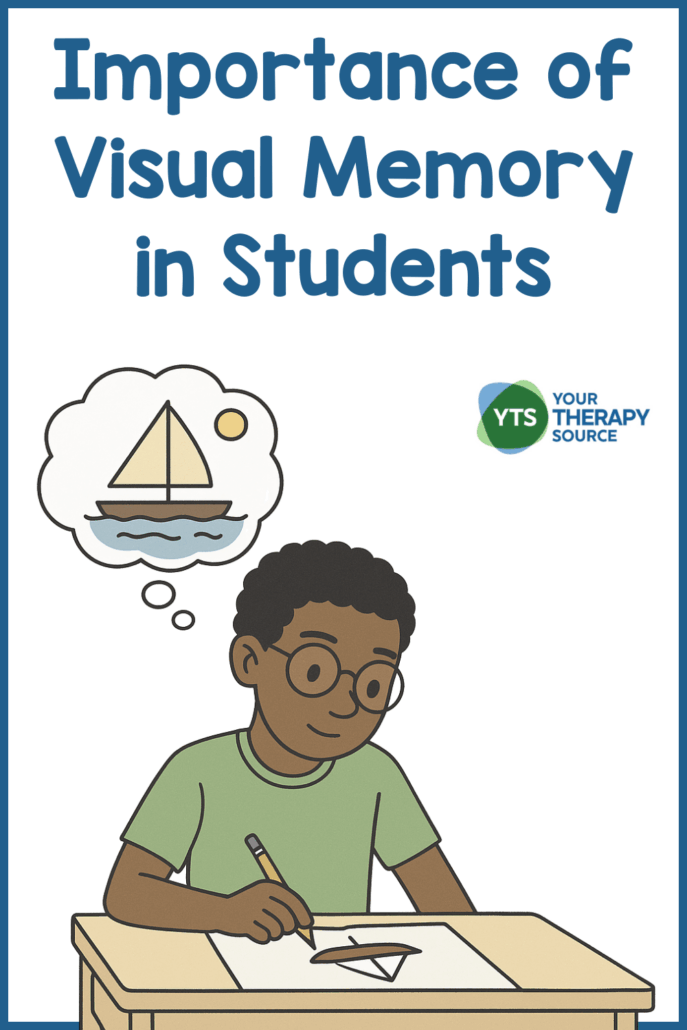
What Is Visual Memory?
Visual memory is the ability to remember and recall what we see. It allows the brain to create mental images of letters, numbers, shapes, words, and scenes and then use those images later for learning and problem-solving.
For example, when a child recognizes a familiar word on a page, they’re using visual memory to retrieve the stored image of that word. When they remember where something was placed in a picture or recall the layout of a worksheet, that’s visual memory at work too.
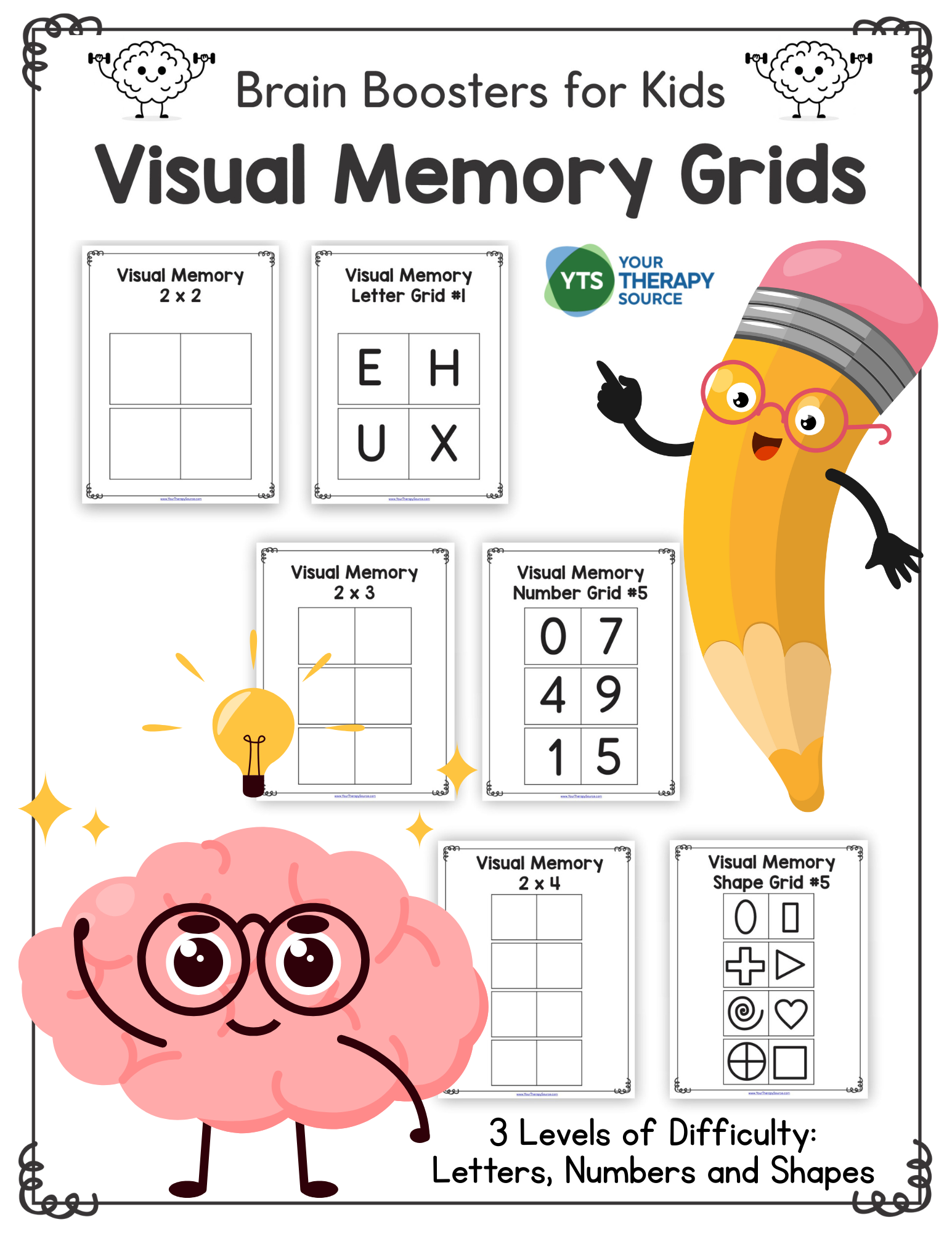
Visual Memory Grids
How Visual Memory Works in the Brain
When children see something, their eyes send information to the occipital lobe, which processes the image. The parietal and temporal lobes then help interpret spatial relationships and object meaning. The visual memory network—including parts of the hippocampus and prefrontal cortex—stores and retrieves this visual information when needed.
In simpler terms, visual memory depends on both visual perception (recognizing what we see) and working memory (holding onto that image long enough to use it). These brain areas must communicate efficiently for a child to read fluently, copy accurately, and comprehend visually presented material.
The Types of Visual Memory
Visual memory develops through a series of stages that help the brain take in, store, and use what it sees. These stages: sensory memory, short-term visual memory, visual working memory, and long-term visual memory that work together to support learning, reading, writing, and problem-solving.
Sensory Memory (Iconic Memory)
Sensory memory, also called iconic memory, is the brain’s first stop for visual input. It holds raw visual information for only a split second (less than one second) after something is seen. This allows the brain to process continuous images from the environment, like frames in a movie.
For example, when a child glances at a pattern or letter and it briefly “lingers” in their mind’s eye, that’s sensory memory at work. If the information is attended to, it moves into short-term visual memory; if not, it quickly fades.
Short-Term Visual Memory
Short-term visual memory holds small amounts of visual information for a few seconds. It allows a student to remember what they just saw long enough to complete a task—like copying a few numbers from the board or recalling where an image appeared on a worksheet. This memory fades quickly unless it’s rehearsed or linked to meaning.
Visual Working Memory
Visual working memory goes a step further by holding and manipulating visual information in the moment. It’s what allows students to recall the shape of a letter while writing it, or picture a diagram while solving a problem.
Working visual memory relies on the prefrontal cortex and is part of the brain’s executive function system, which coordinates attention, planning, and organization.
Long-Term Visual Memory
Long-term visual memory stores visual information over hours, days, or years. It’s what enables a student to recognize familiar letters, sight words, math symbols, or even the layout of their school.
This stage depends on the hippocampus and other brain regions involved in consolidation, turning short-term memories into lasting knowledge through repetition and meaning.
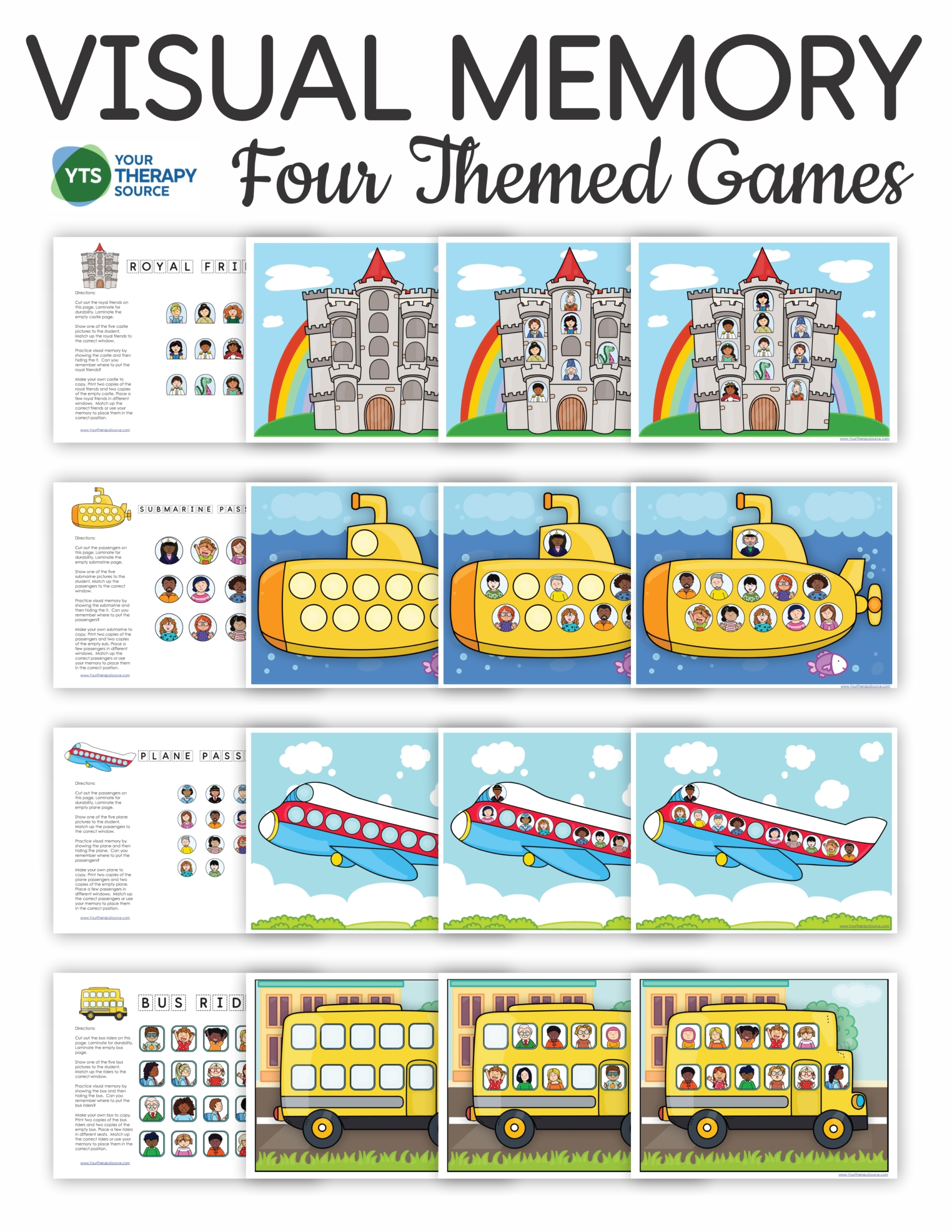
Visual Spatial Memory Games – Interactive for Distance Learning or Print
How Visual Memory Develops
Visual memory grows steadily through early childhood as children explore and make sense of their surroundings.
- Toddlers begin recognizing familiar faces, toys, and shapes.
- Preschoolers start recalling patterns, letters, and simple pictures.
- Early elementary students develop stronger working visual memory for reading, writing, and math tasks.
- Older students use visual memory for studying, note-taking, and visualizing multi-step instructions.
Development can vary widely, and difficulties in this area often appear once academic demands increase especially in reading and spelling.
How Visual Memory Relates to Other Skills
Visual memory is part of a broader system of visual-perceptual skills, which also includes:
- Visual discrimination: noticing differences between similar shapes or letters
- Visual sequential memory: remembering the order of symbols or words
- Visual closure: identifying an object or letter when part of it is missing
- Visual figure-ground: focusing on details within busy backgrounds
When visual memory is weak, these related skills often show signs of difficulty too, such as trouble finding words on a crowded page or remembering letter order when spelling.
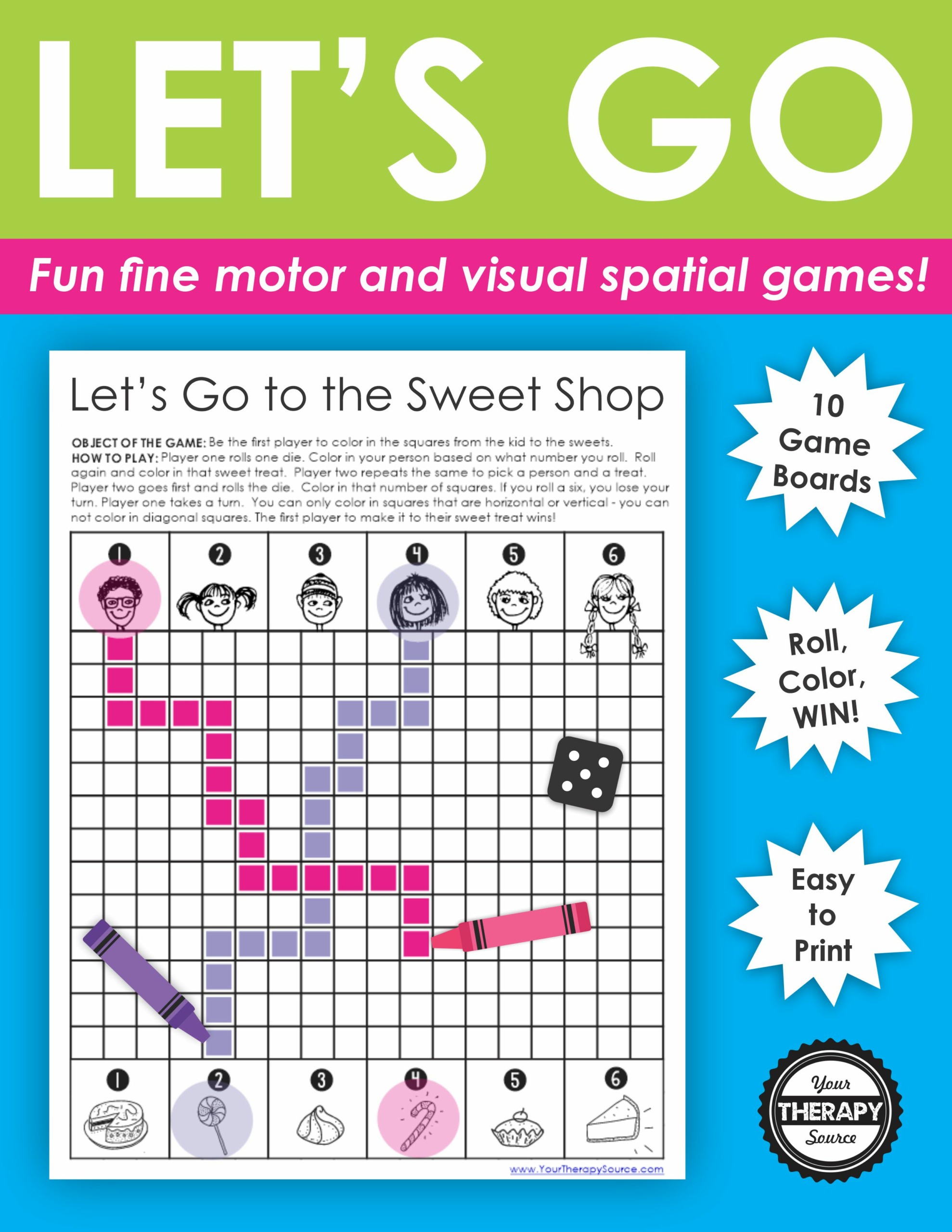
Let’s Go Game – Fine Motor and Visual Spatial Games
When Kids Struggle With Visual Memory
These challenges can affect reading fluency, spelling, handwriting, math problem-solving, and overall classroom performance. Students who have difficulty with visual memory may:
- Struggle to recognize letters, numbers, or words consistently
- Forget what they just read or saw on the board
- Mix up visually similar letters (like b/d or p/q)
- Have trouble remembering visual directions or spatial layouts
- Take extra time to complete written or visual assignments
- Feel easily frustrated or lose confidence in academic tasks
Strategies to Strengthen Visual Memory
Educators, therapists, and parents can all help students build stronger visual memory through consistent, playful, and purposeful practice.
Try These Ideas
- Play “What’s Missing?” or “Memory” games: Start with simple pictures or objects, then gradually increase the number of items.
- Use movement to build memory: Place a visual model (like a pattern or word) across the room. Have the child look, run to another spot, and recreate it from memory.
- Encourage visualization: Ask students to picture a scene, shape, or spelling word in their mind’s eye, then describe or draw it.
- Incorporate multisensory learning: Combine seeing, saying, and doing—like tracing letters while naming them out loud or forming shapes with clay.
- Copy from different distances: Move visual models farther away over time to strengthen short-term and working visual memory.
- Use chunking and repetition: Break down complex visual information into smaller parts and review it frequently to help it transfer into long-term memory.
- Play puzzles and pattern games: Activities like tangrams, visual sequencing, and spot-the-difference puzzles build recognition and recall.
- Encourage drawing from memory: Ask students to look at a picture, study it for 10 seconds, then draw what they remember.
- Add structure and consistency: Using predictable layouts, color coding, and visual cues supports recall and reduces visual overload.
- Celebrate progress: Reinforce effort and improvement, not just accuracy—visual memory strengthens over time with repetition and success experiences.
When to Seek Support
If a child continues to struggle with visual memory despite regular practice, it may be helpful to consult professionals such as:
- Occupational therapists for visual-perceptual and visual-motor skill development
- Optometrists or vision therapists for functional vision assessments
- Educational specialists for academic interventions or accommodations
Early identification and support can make a significant difference in learning confidence and success. Visual memory skills are essential for learning across all subjects. When students can hold, recall, and use visual information effectively, they gain confidence and independence in reading, writing, and problem-solving. With supportive adults providing engaging, multisensory practice, every child can strengthen this vital foundation for academic success.
